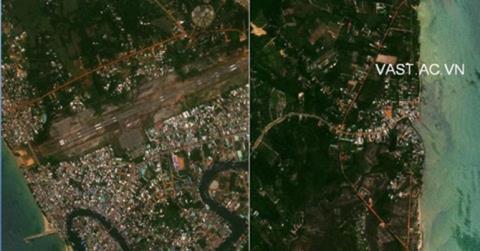VNREDSat-1 satellite capable of taking photos globally
The Vietnamese VNREDSat-1 can take high-quality pictures of any location in the world, not just in Vietnam, which could prove to be useful in the current dispute with China.

A photo of the eastern and western coast of Phu Quoc Island taken by VNREDSat-1.
Dr. Bui Trong Tuyen, head of the Small Satellite Project Management, and deputy head of the Vietnam Space Technology, an arm of the Vietnam Academy of Science and Technology, spoke about the satellite’s capabilities in an interview given to Dat Viet newspaper several days ago.
He said this was welcome news for the Vietnamese public who have heard recent reports that China is building a fake island on the Gac Ma Reef in the Vietnamese Hoang Sa Archipelago.
The Philippines has also officially accused China of illegally building an airport in the Vietnamese reef in the Truong Sa archipelago, showing images that it has taken with its satellites.
Deputy Prime Minister Pham Binh Minh recently stated that Vietnam is checking the information, and if it is true, will take necessary actions to protest against China’s wrongful act.
In order to do that, Vietnam needs to find convincing proof, including pictures, before coming to a conclusion.
VNREDSat-1, which was successfully launched into orbit on May 7, 2013, has been operating smoothly, according to Tuyen.
Just two days after launching, the Vietnamese remote sensing image station received its first images sent by the satellite.
VNREDSat-1 regularly takes pictures for different purposes to satisfy the different demands of individuals and institutions.
Tuyen denied that the Filipino satellite could take pictures showing changes on Gac Ma Reef, but the VNREDSat-1 could not. He pointed out that the satellite is a major Vietnamese project with huge investment capital and advanced technology.
He said that pictures of Gac Ma Reef are marked as top confidential documents, and military secrets could not be released to the public.
“Though scientists receive images to serve their research, it is only the ministries of Public Security and National Defence which have the right to have regular supervision,” he explained.
“While our research work serves socio-economic development projects, the Ministry of National Defence’s research is aimed at security and national defence purposes,” he said.
VNREDSat-1 had total investment capital of Euro55.8 million, built with ODA (official development assistance) from the French government and VND64.82 trillion of reciprocal capital from Vietnam.
Since it was put into operation, a report said, it has taken 20,719 pictures, including 6,071 pictures of sites in Vietnamese territory and 14,648 pictures of places outside Vietnamese territory.
Before being handed over to Vietnam, the satellite had taken 3,661 pictures. As for waters and islands, the Vietnamese satellite has to date taken 1,557 pictures of sites that cover a total area of 240,000 square kilometers.








